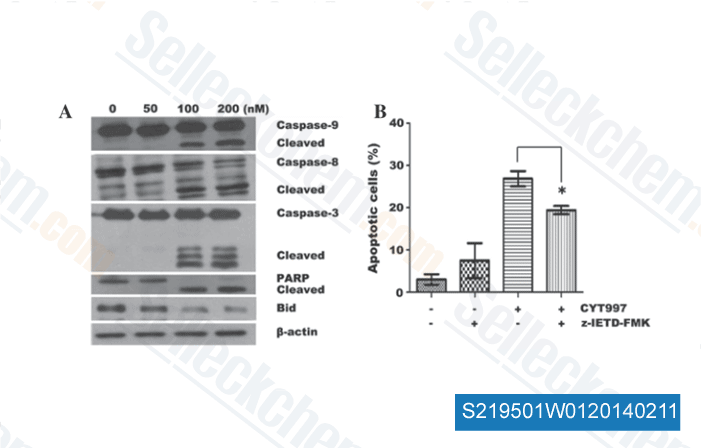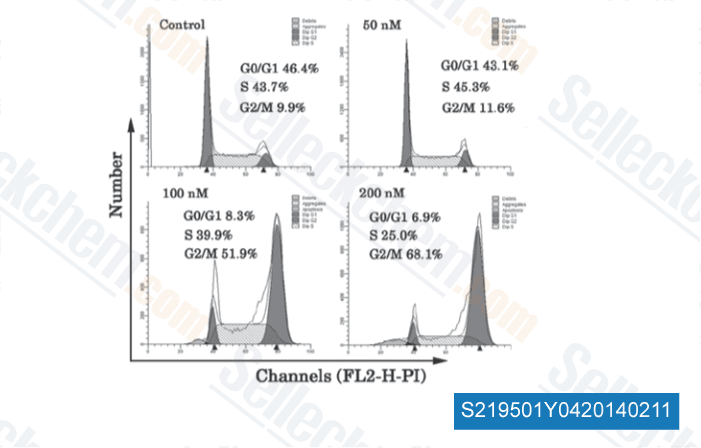|
Toll Free: (877) 796-6397 -- USA and Canada only -- |
Fax: +1-832-582-8590 Orders: +1-832-582-8158 |
Tech Support: +1-832-582-8158 Ext:3 Please provide your Order Number in the email. |
Technical Data
| Formula | C24H30N6O2 |
||||||
| Molecular Weight | 434.53 | CAS No. | 917111-44-5 | ||||
| Solubility (25°C)* | In vitro | DMSO | 86 mg/mL (197.91 mM) | ||||
| Ethanol | 20 mg/mL (46.02 mM) | ||||||
| Water | Insoluble | ||||||
| In vivo (Add solvents to the product individually and in order) |
|
||||||
|
* <1 mg/ml means slightly soluble or insoluble. * Please note that Selleck tests the solubility of all compounds in-house, and the actual solubility may differ slightly from published values. This is normal and is due to slight batch-to-batch variations. * Room temperature shipping (Stability testing shows this product can be shipped without any cooling measures.) |
|||||||
Preparing Stock Solutions
Biological Activity
| Description | Lexibulin (CYT997, SRI-32007) is a potent microtubule polymerization inhibitor with IC50 of 10-100 nM in cancer cell lines. Phase 2. | ||
|---|---|---|---|
| Targets |
|
||
| In vitro | CYT997 (1 μM) treatment for 24 hours in A549 cells induces rapid reorganization of microtubules including the destruction of the existing microtubule network and accumulation of tubulin in plaques within the cytoplasm of some cells, leading to significant cell morphology alterations including the loss of adhesion and cell rounding. CYT997 displays potent cytotoxic activity against a range of 16 cancer cells with IC50 ranging from 9 nM for HepG2 to 101 nM for KHOS/NP. Especially, CYT997 exhibits potent activity against HCT15 cells, known to possess the multidrug resistance mechanism Pgp (MDR+), with IC50 of 52 nM. Through inhibition of microtubule polymerization, CYT997 blocks the cell cycle at the G2-M boundary, and induces an increase in phosphorylated Bcl-2 and increased expression of cyclin B1, as well as caspase-3 activation and the generation of poly (ADP-ribose) polymerase. CYT997 treatment causes a rapid and reversible increase in the permeability of HUVEC monolayers with IC50 of ~80 nM at 1 hour of exposure. [1] Consistent with the disruption of cellular tubulin, CYT997 potently inhibits proliferation, induces cell cycle arrest and most importantly apoptosis of both human myeloma cell lines (HMCLs) and primary MM cells. [2] | ||
| In vivo | The half-life of CYT997 for oral administration (2.5 hours) to rats is slightly longer than that for intravenous administration (1.5 hours), with the absolute oral bioavailability being 50% to 70%. Oral administration of CYT997 induces dose-dependent inhibition of tumor growth of PC3 xenografts in mice, more potently compared with paclitaxel. CYT997 is also effective in an orthotopic syngeneic model using the mouse breast cancer 4T1 cells, which are some refractory to Paclitaxel treatment. A single dose of CYT997 (7.5 mg/kg, i.p.) reduces tumor blood flow significantly at 6 hours in liver metastases, to a similar extent as the positive control CA4P dosed at 100 mg/kg. [1] CYT997 treatment (15 mg/kg/day) significantly prolongs the survival in a murine model of aggressive systemic myelomatosis. [2] |
Protocol (from reference)
| Kinase Assay:[1] |
|
|---|---|
| Cell Assay:[1] |
|
| Animal Study:[1] |
|
References
|
Customer Product Validation

-
Data from [ Exp Ther Med , 2013 , 6(2), 299-304 ]

-
Data from [ Exp Ther Med , 2013 , 6(2), 299-304 ]

-
Data from [ Exp Ther Med , 2013 , 6(2), 299-304 ]

-
Data from [ Exp Ther Med , 2013 , 6(2), 299-304 ]
Selleck's Lexibulin (CYT997) Has Been Cited by 8 Publications
| A modular master regulator landscape controls cancer transcriptional identity [ Cell, 2021, 184(2):334-351.e20] | PubMed: 33434495 |
| HBV Core Promoter Inhibition by Tubulin Polymerization Inhibitor (SRI-32007) [ Adv Virol, 2020, 2020:8844061] | PubMed: 33110426 |
| CYT997(Lexibulin) induces apoptosis and autophagy through the activation of mutually reinforced ER stress and ROS in osteosarcoma [ J Exp Clin Cancer Res, 2019, 38(1):44] | PubMed: 30704503 |
| Intracellular reduction in ATP levels contributes to CYT997-induced suppression of metastasis of head and neck squamous carcinoma. [ J Cell Mol Med, 2019, 23(2):1174-1182] | PubMed: 30450674 |
| Survival of midbrain dopamine neurons depends on the Bcl2 factor Mcl1 [ Cell Death Discov, 2018, 4:107] | PubMed: 30479840 |
| Augmentation of the anticancer activity of CYT997 in human prostate cancer by inhibiting Src activity. [ J Hematol Oncol, 2017, 10(1):118] | PubMed: 28606127 |
| Structures of a diverse set of colchicine binding site inhibitors in complex with tubulin provide a rationale for drug discovery. [ FEBS J, 2016, 283(1):102-11] | PubMed: 26462166 |
| The microtubule depolymerizing agent CYT997 effectively kills acute myeloid leukemia cells via activation of caspases and inhibition of PI3K/Akt/mTOR pathway proteins. [XIAOHUI CHEN, et al. Exp Ther Med, 2013, 6(2):299-304] | PubMed: 24137178 |
RETURN POLICY
Selleck Chemical’s Unconditional Return Policy ensures a smooth online shopping experience for our customers. If you are in any way unsatisfied with your purchase, you may return any item(s) within 7 days of receiving it. In the event of product quality issues, either protocol related or product related problems, you may return any item(s) within 365 days from the original purchase date. Please follow the instructions below when returning products.
SHIPPING AND STORAGE
Selleck products are transported at room temperature. If you receive the product at room temperature, please rest assured, the Selleck Quality Inspection Department has conducted experiments to verify that the normal temperature placement of one month will not affect the biological activity of powder products. After collecting, please store the product according to the requirements described in the datasheet. Most Selleck products are stable under the recommended conditions.
NOT FOR HUMAN, VETERINARY DIAGNOSTIC OR THERAPEUTIC USE.
